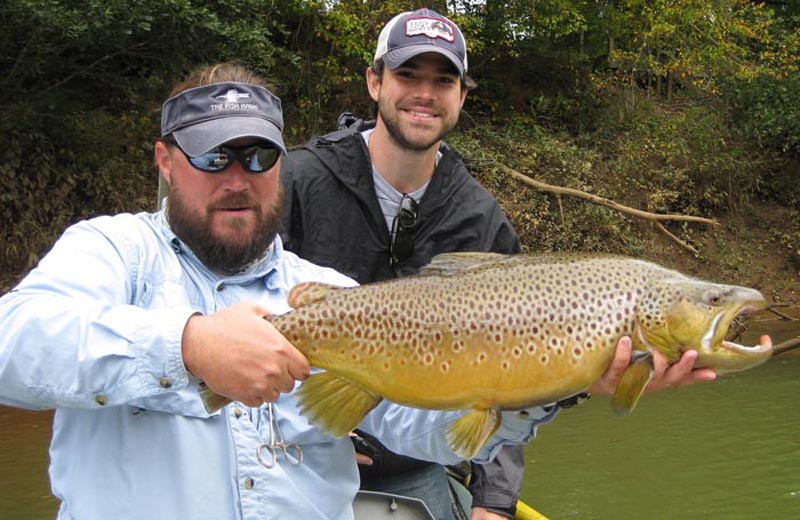
A Chattahoochee River fall wild brown trout [Salmo trutta] on a big, articulated trout streamer named Chewie, a Bryson original. Alaska, Georgia, Tennessee, North Carolina fishing guide and casting instructor Chad Bryson with a happy client. Image credit Chad Bryson. Was it the CHEWIE we knew in Star Wars? Bryson is one of the best fly fishing guides in the Southeast.
It’s streamer time of year and maybe a popper or two
By Skip Clement
I love this time of year, fall, and fly fishing it. I do not like the leaves and block-long school bus lines. I like the trout and weather yielding to my needs when the weather turns cold. The crowds of anglers are gone having chosen not to fish midday, and the trout want to feed at midday.
In late fall fly fishing to most means all the instincts of trout get muted? Even though the water temperatures mirror spring, the best hatches already happened, except for occasional flying ants – depending on where you live.
Too, once the air temperature stays in the high 40 degrees during the day, it’s physically comfortable and the best time for late fall trout fishing is lunchtime until late afternoon.
The solitude factor, but bring your best game
Angie, my lawyer friend, and I have the river to ourselves, and we’re okay with knowing the trout don’t feed as heavily or as often in the fall as they do in the spring and summer. We learned that 12-foot or even longer leaders work best on low, slow, and super clear late fall water.
We sometimes see a local fish biologist who says that trout have been stepped on all year and now spook if lined even a bit, like any leader section. Good casting, she says, is paramount.
Rainy and windy
Blustery fall days produce many leaves and debris making it challenging for trout to discern what is what. Try a hopper in this condition. Little, I mean little, twitches during a drift and trout can determine that it’s food. Remember cold, rainy, and windy is streamer time, mostly deep water and at the tails of pools
“Brown and brook trout migrating before spawning in late November often stack up at the back end of pools, and although they don’t usually eat once they get spawning on their minds, they get pretty aggressive, taking a swat at anything in their way. It helps to have a sink-tip line handy, to get your fly swung across a trout’s nose in the deeper pools.” — Orvis

Trout cutthroat fish oncorhynchus clarkii clarkii. Art by Timothy Knepp, U.S. Fish and Wildlife Service, a commons image.
Please don’t leave them in the truck
A fall caddis hatch or some big mayflies may just put on a show for a bit. Try nymphs; they’re always effective – small olive mayflies, midge pupae, and so on.
There isn’t any need to rearm with a new or different rod and accouterments for fall. The only change would be the leader length. If you’re a dedicated dry fly person, that’s another story.






